Our A to Z guide to the towns and villages of Lake Maggiore
For those planning a holiday in the Italian Lakes, this A to Z guide to all the towns and villages on Lake Maggiore should provide you with all the holiday reading you need ahead of your stay, making sure you hit the ground running!
Arcummegia
Arcumeggia is a small village on the hillside above Lake Maggiore. In 1956 the Provincial Tourism Authority decided to turn it into a painting village. After that decision, so many artists arrived in the village that they began painting frescoes on the walls of the village houses. It’s a fascinating village to stroll around if you have an interest in art. New paintings are still added each year so it has almost become an open-air contemporary art museum.
Arona
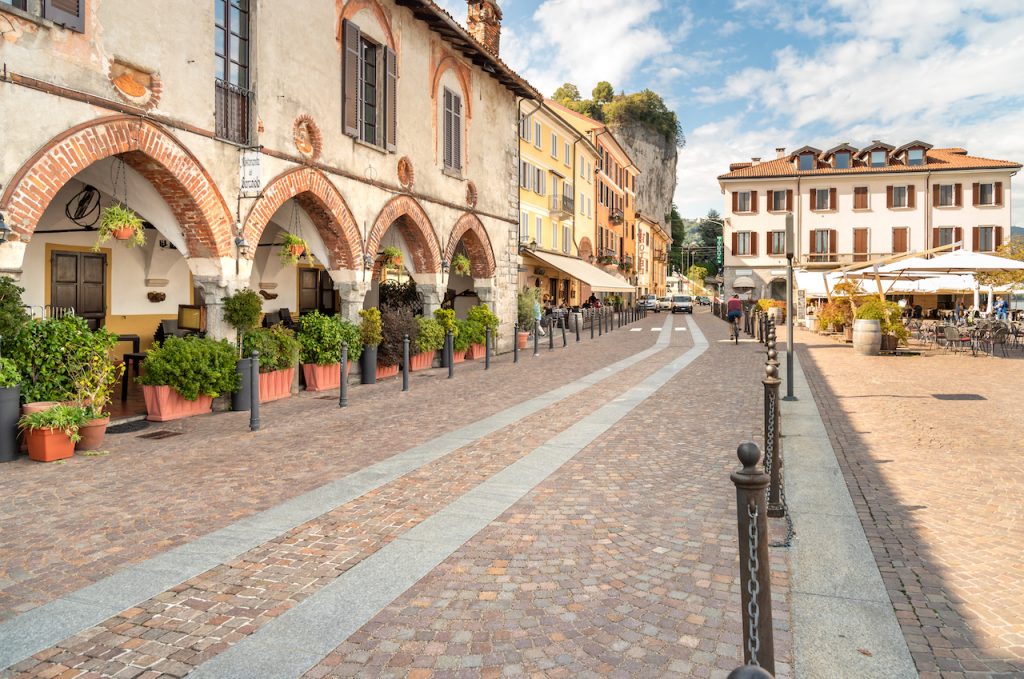
Arona is a very pretty lakeside town well worth a detour to see. It has a charming lakeside promenade from which lead off narrow cobbled streets lined with shops, cafes and restaurants. It boasts good train and boat links.
The town’s history dates back to Roman times but the period of history which is most prominent for visitors to see today is that in which it was in the possession of the powerful Borromeo family. Arona was home to Carlo Borromeo. He was a prominent cardinal who founded several seminaries and put in place a number of significant reforms during the Counter Reformation. A towering statue of Carlo Borromeo can be seen today sitting above Arona on the Sacro Monte di San Carlo. This was actually the tallest statue in the world until the Statue of Liberty was erected in 1886. It is called the San Carlone and stands at 35 metres tall. It is possible to climb up inside the statue and look out over the lake through his eyes and ears. A path leads from the Piazza del Popolo in the centre of Arona to the hillside sanctuary where, as well as the towering statue, there are 3 chapels.
Also worth visiting in Arona is the Rocca. This is a military fortress dating back to the 900s but reinforced in the 12th century to protect against the continued attacks by Frederick Barbarossa (Red Beard). This was ceded to the Borromean family in 1439. They then added an additional wall and a secret street. Unfortunately, the building was destroyed by Napolean in 1800 but the remains are now set in a park and enjoy wonderful lake views.
Finally, for history lovers, there is a Minerology Museum and Archeology Museum in the town.
It’s well worth spending a couple of hours exploring the town or stopping here for a meal or leisurely drink in one of the bars or cafes.
Fancy using Arona as a base for your Italian Lakes holiday? Then check out this 2 bedroom apartment near Arona.
Ascona
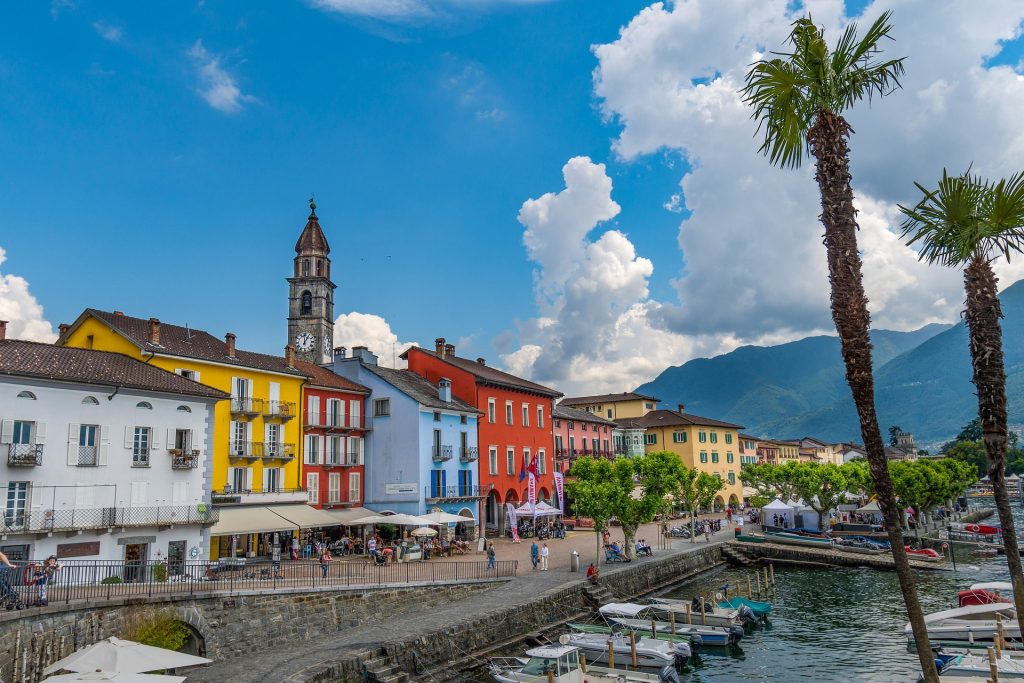
Situated in the Swiss part of the lake, Ascona has an extremely pretty pedestrianised lakefront. Trees line one side of the promenade whilst on the other sit numerous excellent restaurants and stylish cafes. Whilst the food all around Lake Maggiore is of a high standard (as you’d expect anywhere in Italy), if you’re looking for fine dining, then Ascona is the place to head. Ascona boasts no less than 3 restaurants with a Michelin star. The resort of Ascona also boasts a beautiful 18 hole golf course, a lido with large open air swimming pool and beach area, tennis courts and a number of hotels.
The most notable building in the town is probably the church of San Pietro e Paolo which dates back to the 16th century and whose high bell tower is easy to spot above Ascona’s other buildings.
Behind Ascona sits the Monte Verita (Mountain of Truth). This has been the site of many different Utopian and cultural events and communities over the years, the first being the Cooperative Vegetarian colony Monte Verita, set up by Ida Hofmann and her companion, Henry Oedenkoven. These days it is home to a museum which showcases the history of this and other colonies as well as a location for seminars held by both the universities of Lucerne and Zurich.
Ascona also plays host to the annual Ascona Jazz Festival. Held over 10 days at the end of June and beginning of July, the festival is devoted to historical styles of jazz, particularly the style originating in New Orleans. Typically, the festival will include more than 200 concerts and 300 musicians as well as featuring films, conferences, exhibitions and much more.
For those more interested in classical music, Ascona also hosts the Settimane Musicali di Ascona every September. Featuring a rich programme of symphony concerts, chamber music evenings and recitals it is a fantastic classical music festival. Many of the concerts take place in the Collegio Papio church in Ascona and the San Francesco church in nieghbouring Locarno.
It’s also a short boat from ride Ascona to the Brissago Islands. These are two islands – San Pancrazio (also known as Grande Isola since it is the larger of the two islands) and Isolino or Isola di Sant’ Apollinare (also known as Isola Piccola for obvious reasons!) The latter is not open to the public but the larger of two is well-known for its botanical gardens, earning it the nickname ‘The Swiss Garden of Eden’. This is home to over 1600 species of plants, some extremely rare, and is divided into five main sections – the Mediterranean, Asia, Africa, the Americas and Oceania. It’s home to a bamboo forest, numerous orchids, palms, cacti and other tropical plants.
Baveno
A small but bustling village, Baveno sits nestled beside its more famous neighbor, Stresa. Its position enjoys excellent views of the Borromean islands which can be reached by boats leaving from the town’s harbor. It’s also home to a number of opulent villas, most dating back to the 19th century. These include Villa Henfrey-Branca, Villa Fedora, Villa Barberia, Villa Durazzo, Villa Brandolini d’Adda, Villa Carosio and Villa Claudia. Many of these villas have hosted a number of famous visitors in their time. For example, Villa Henfrey-Branca played host to none other than Queen Victoria who visited with her daughter, Beatrice, in 1879 whilst Villa Durazzo (now the Lido Palace Hotel) provided the setting for Winston Churchill to enjoy his honeymoon in 1908.
The legacy of one of the residents of Villa Fedora lives on today. The most famous resident of Villa Fedora is the classical composer, Umberto Giordano who lived here for 20 years and worked on many of his most famous works within its walls. Since 1998, the Umberto Giordano Festival has been celebrated in July each year with a series of events not just focused on music but also including other performing arts including poetry, theatre, photography and art. Many of the concerts and exhibitions are free to attend but some involve a small charge. They are held not just in Baveno but also in Stresa and Feriolo.
This 2 bedroom apartment in Baveno is a few minutes walk from the town’s harbour, shops and restaurants.
Belgirate
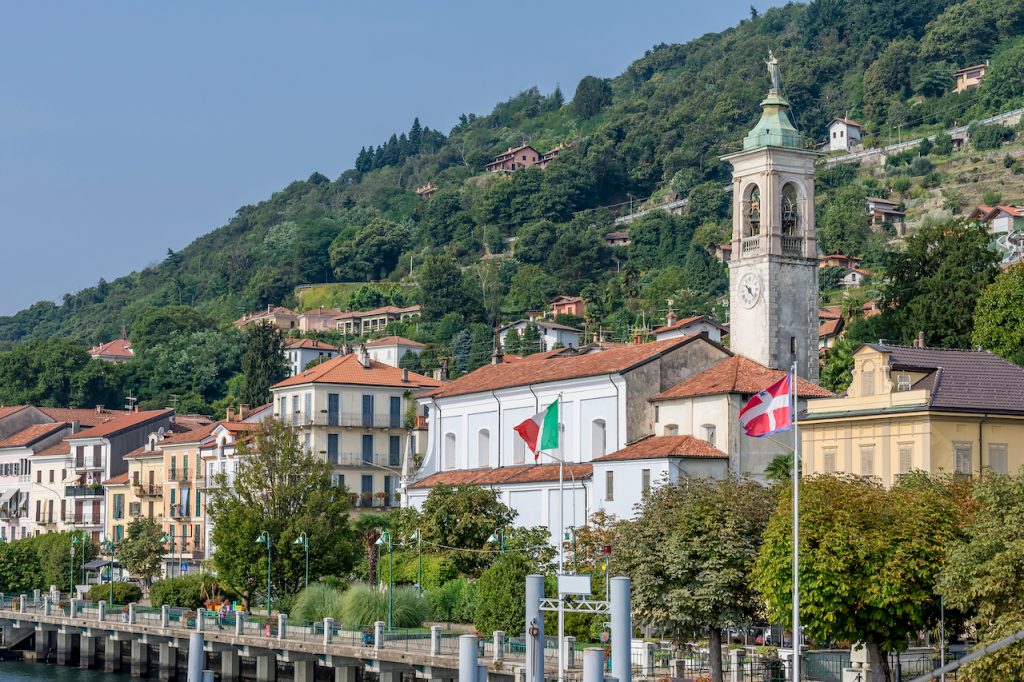
Belgirate has a rich history and has been home to many key historical figures over the years. As a result, it can now boast a number of stunning villas and mansions, all set in stunning gardens and parkland. Among the most famous of these are Villa Fontana, Villa Carlotta, Villa Bonghi, Villa Cairoli and Villa Principessa Mathilde which was once the lakeside residence of Napolean’s niece. The oldest of these is Villa Fontana built in the 18th century and which boasts spectacular English style gardens with majestic palms, beautiful magnolias and huge monkey puzzles. Villa Carlotta was built by the Beretta family in the 19th century but since the 1950s has been a hotel whose guests have included Brigitte Bardot.
Another building of note in Belgirate is the Church of Santa Maria. Sitting just above the town, it enjoys wonderful views of Lake Maggiore but also hosts a number of the concerts that make up the Settimane Musicale di Stresa each Summer.
Brezzo di Bedero
Brezzo di Bedero is a pretty hilltop village overlooking Lake Maggiore. It is also home to the Romanesque Collegiate Church of San Vittore, which plays host to a series of classical music concerts every Summer.
We love this 3 bedroom apartment in Brezzo di Bedero. It enjoys phenomenal 180 degree lake views and is a short walk from the nearest restaurant.
Cannero
Affectionately known as the ‘Riviera of the Lakes’ thanks to its sheltered position and surprisingly Mediterranean climate, enjoying plenty of sunshine and mild winters. Visitors will find pots filled with lemon and orange trees thriving here, along with stunning camellias, olives, oranges and palms that you would more usually expect to see further South in Italy. Residents of Cannero will also grow other citrus fruits including tangerines, clementines and even grapefruit.
The village has a lovely promenade that leads past the shops and restaurants to a pebbled beach area where visitors can hire pedaloes and take a swim in the lake waters. Looking from Cannero towards the lake, you can enjoy a lovely view of the Castles of Cannero across to Luino on the other side of the lake. The Castles of Cannero are situated on three small islands just off the Cannero shoreline. Unfortunately, visitors are prohibited from visiting as they are unsafe but it’s still enjoyable to view them from the shore or to hire a boat to get a closer glimpse at a safe distance on the water. The castles are actually all that remains of the Rocca Vitaliana fortress which was built by Ludovico Borromeo between 1519 and 1521 to defend the upper part of the lake from the Swiss after the Duchy of Milan lost control of the Ticino Canton.
Take a walk along the many paths that lead from the lakeside into the hills behind and you will come across a number of enchanting villages including Oggiogno and Piancassone (famous for its grappa). Keep an eye out to spot a number of hollow, round stone mortars en route. These were once used to grind walnuts and flax seed as well as for pressing olives. Keen hikers should also drive a little further on to Piancavallo half an hour away from the reserve. There is a car park here where you can start a really enjoyable hike. The route takes you along the Cadorna Line. The Cadorna Line was a defence line between Lake Maggiore and the Ossola Valley. Consisting of a network of military mule tracks, trenches, artillery positions, lookout posts, logistical structures and command centres, it was built between 1916 and 1918 as a defence against a possible German – Austrian attack. These days it provides an extremely interesting historical hiking route. Or head a little further on to enjoy a unique zipline that goes from Pian d’Arla to Alpe Segletta. The route is 1850 metres long with a drop of 350 metres at its highest point. The ride lasts 90 seconds reaching speeds of up to 120 km per hour.
Visit Cannero in the Spring and try to coincide your visit with the annual Camellia Show and Citrus Fruit festival. The latter spans 9 days each March followed closely by the 2 day Camellia show (‘Camellia in Mostra).
Cannobio
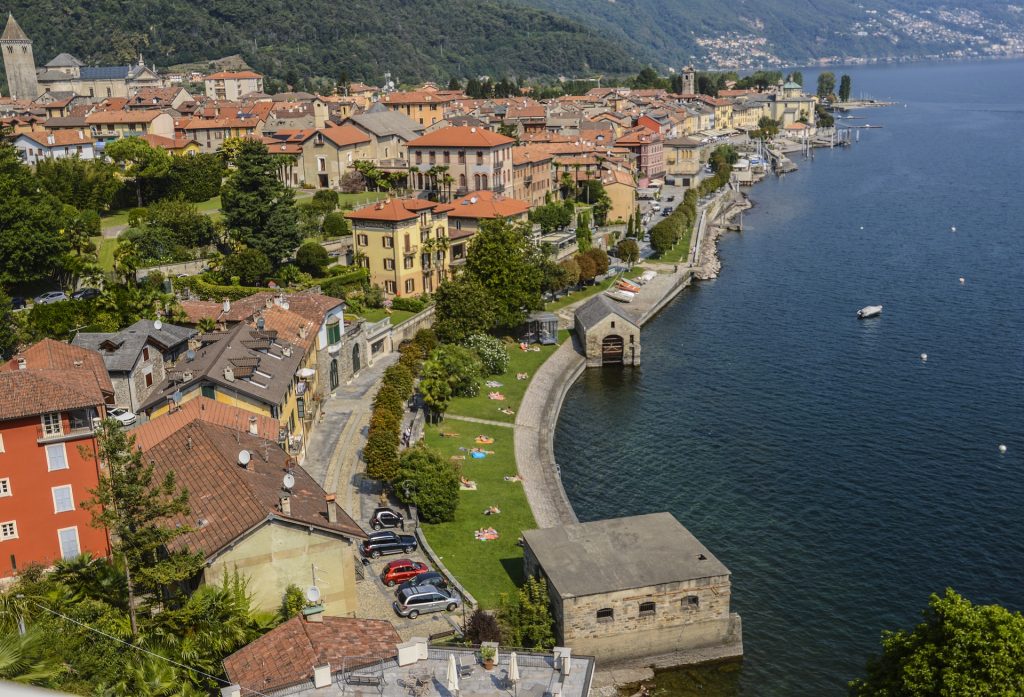
Cannobbio is a very pretty lakeside town. The town boasts a Sunday market throughout the Summer. Take a stroll along the picturesque waterfront promenade to the lido at the far end of the town. This is a popular spot for sunbathers and also boasts an excellent water sports centre. Or head from the harbour in Cannobio in the other direction and you will meander up the sloped streets lined with old houses, shops, cafes and restaurants. Many of the buildings date from the 18th and 19th centuries and the town was constructed in such a way as to form a defence against any invasions from the lake with narrow streets, tall buildings and plenty of steps to climb.
Some of the buildings worth seeing in the town include the 18th century San Vittore church, the late 13th century Palazzo della Ragione which was once the town hall and which is now known more commonly as ‘Parasio’. Another church worth a visit is the Sanctuary of the Santissima Pieta. In 1522 this was where the supposed miracle of the ‘sacred rib’ took place. Residents still celebrate the event annually on 7 January with the festival of the lights (Lumineri). Whether you believe in the miracle or not, it’s a picturesque event in which the lakefront and old quarter of the town as well as the boats that sit in the water, are lit purely with candles and lanterns. Celebrate the event with a traditional meal of bean soup and luganighette beef sausages.
To the rear of Cannobio is a walk which takes you to the dramatic gorge and waterfall of the Orrido di Sant’ Anna. Take your swimming costumes and you can enjoy a plunge in the water here. Or take the time to take a look in the old church or to enjoy a drink or meal at the restaurant that sits just behind it.
The roads behind Cannobio lead into the Cannobina Valley which forms part of the Val Grande National Park. The scenery here is spectacular and it truly is the perfect spot for hikers, walkers and nature lovers.
Find out more in our guide to Cannobio.
Castelveccana
A small village on the Eastern shores of the lake, Castelveccana is home to the 12th century Church of San Giorgio. Whilst the church may not seem exceptional, it does have one very different feature to most churches around the world in that its entrance lies on the long side of the building and not the short one.
Colmegna
Colmegna is a tiny, but pretty lakeside village on the Eastern shores of Lake Maggiore. Whilst there is perhaps not much reason to stop unless you are staying here, there is a small beach area where visitors can sunbathe and enjoy a dip in the lake. And it also boasts a superb restaurant at the local hotel – the Camin Hotel.
This 4 bedroom family friendly villa in the Italian Lakes is just a 15 minute walk from the lakeside at Colmegna.
Dormelletto
This is the location of an extensive nature reserve, home to several species of fish and birds. A series of cycle tracks and pathways criss-cross the reed beds here making it an ideal place for either walkers or cyclists.
Dumenza
A sleepy village, Dumenza has a small cafe / bar, restaurant and supermarket. Some lovely walks start from Dumenza and head into the surrounding hills.
Enjoy an authentic stay here at Villa Caruso, a 3 bedroom villa in the Italian Lakes.
Germignaga
Germignaga is a traditional lakeside town. Keen cyclists may want to visit the bike store within the town where bikes can be hired. The lakeside promenade has undergone significant investment here in recent years and now boasts a lovely modern play park for younger children.
Ghiffa
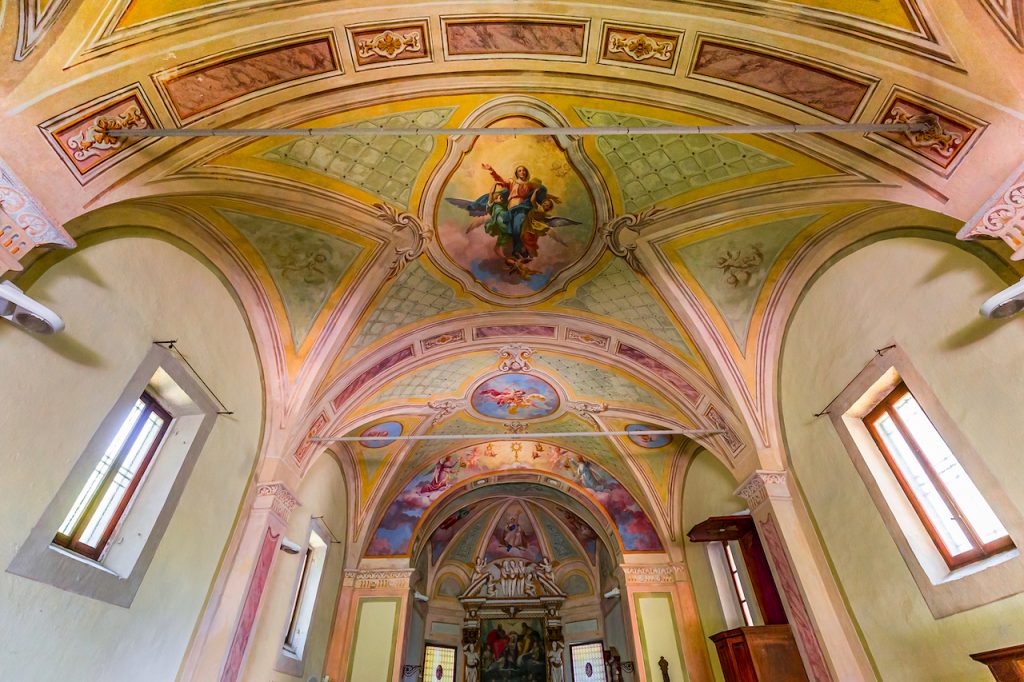
Ghiffa is best known for being home to the Sacred Mountain of the Most Holy Trinity – the Sacro Monte di Ghiffa. The latter is one of nine mountain sanctuaries in Lombardy and Piedmont that are now UNESCO World Heritage sites. The nature park enjoys incredible views and extends across hundreds of hectares of mountain terrain, dotted with a series of Baroque style chapels and sanctuaries, decorated with both Old and New Testament scenes. Numerous paths and trails meander through the woods and overlook the lake below. There is also an archeological trail exploring the primitive remains of a prehistoric population.
Ghiffa also has another claim to fame, that of being the location for a hat museum – the Museo del Capello. There was a time when the felt hat that it celebrates was worn by all men. Now the museum tells the story of this once thriving trade.
Gignese
Gignese can lay claim to be the only town in the world to have a museum entirely devoted to umbrellas and parasols. There are over 1000 on display for visitors to see, some of which have belonged to key historical figures including Queen Margherita of Savoy. The museum also educates its visitors on the history of the items and how they are made.
Intra
Intra unfortunately cannot boast a great deal for visitors to stop and enjoy before they jump on the car ferry that will take them across the lake to Laveno. However, it does have a historic centre and is a pleasant spot for a stroll.
Isola Bella

Isola Bella is one of Lake Maggiore’s most famous tourist attractions and home to the Baroque 17th century Palazzo Borromeo. Its gardens are quite spectacular and are filled with landscaped terraces, white peacocks, ponds, fountains, statues and grottoes. Many of the plants are extremely rare, only able to thrive here because of the incredibly mild climate It is possible to buy a ticket to enter the palace and explore many of its rooms, each furnished with incredible antiques and adorned with priceless works of art. Head to the adjacent shops afterwards to pick up a souvenir before heading back to the mainland.
Isola Madre

Isola Madre is the largest of the Borromean Islands and is in large part a botanical garden. It is also home to another palace, built in the 16th century. Visitors can enjoy a tour of this historic residence, home to some beautiful rooms such as the Doll’s Room which is filled with dolls dating from the 19th and 20th centuries, the Room of the Seasons and a room devoted to the Puppet Theatre. The latter was designed by a scenographer from Milan’s La Scala. Outside, the botanical gardens are spectacular, home to a huge variety of rare trees, exotic plants and flowers. Just like on Isola Bella, visitors will be able to admire the peacocks roaming wild, whilst up above, budgerigars fly above you. The gardens occupy a space of nearly 20 acres in total, filled with colourful azaleas, camellias and rhododendrons. It is also home to the largest Kashmir Cypress in Europe along with numerous lemon and lime trees. Also of note is the staircase of the dead – scala dei morti – which is adorned with beautiful wisteria.
Isola Pescatori
Isola Pescatori (also known as Isola Superiore) is so-named because of the fisherman that live on the island and, in fact, is the only one of the Borromean islands to be inhabited. Catch a boat to the island and enjoy a stroll around its narrow village lanes. You’ll notice that the houses are quite distinctive with long balconies that were traditionally used to dry the fish. The pointed spire of the island’s Church of San Vittore can not be missed, rising up above the roofs. This is where you will fine wooden busts of the two patron saints of fishermen – Peter and Andrew – as well as a 16th century fresco of Sant’ Agata. Nowadays, the island boasts some superb fish restaurants so don’t miss a chance to eat some freshly caught fish before heading back to the mainland.
Laveno
Laveno is quite a bustling lakeside town where visitors can catch the car ferry across the lake to Intra on the other side. It also enjoys good train links to Milan. Visitors heading to the lakeside town should head to the ‘bucket lifts’ situated just outside the main town centre. Whilst the lifts may not be for the feint hearted, for those brave enough to try out either the open top or closed buckets, you will be rewarded with the most incredible views at the top of the hillside.
Lesa
Nestled between Stresa and Meina, Lesa is a laid back, attractive town on the shores of Lake Maggiore. It can boast a number of elegant villas and palazzi including Villa Campari, once owned by the family of Campari liqueur and subsequently by the former Italian prime minister, Silvio Berlisconi. Another of these villas – Palazzo Stampa – is now home to a museum dedicated to Alessandro Manzoni, a 19th century Italian poet most famous for his work ‘The Betrothed.’ A visit to the museum will provide a chance to see a number of books, letters and manuscripts as well as memorablia relating to the life and works of Manzoni.
It also has a number of ancient churches well worth a visit. These include the Church of San Sebastiano dating from the 1100s (and where the remains of some Roman tombs were once discovered) and the Churches of San Martino and San Giorgio.
This 3 bedroom apartment in Lesa is a stunning base for a holiday on Lake Maggiore. Boasting a stunning swimming pool and exceptional lake views, it is furnished in a modern, contemporary style.
Locarno

Situated in the Swiss part of the lake, Locarno is a popular lakeside town. It can also claim to have the warmest climate of any of the Swiss towns. Some attractions you may like to visit include the Castello Visconteo, now an archaeological museum but whose origins date back to the twelfth century. It’s also worth visiting the Sacred Mount of the Madonna del Sasso. This can be reached either on foot or by the Locarno-Madonna del Sasso funicular. Legend has it that Franciscan friar, Fra’ Bartolomeo, wanted to build a place of worship on the ‘rock’ of Locarno after seeing an apparition of the Virgin Mary. Whether or not you are religious, it is worth a trip if only to enjoy the extraordinary views it enjoys over Locarno, the lake and surrounding mountains.
Each Summer, Locarno hosts the famous ‘Moon and Stars’ music festival, a series of concerts set over two weeks which in recent years have included the artists Lenny Kravitz, Duffy, Paolo Nutini, Amy Macdonald, Placebo, Gloria Estefan, Katie Melua, Deep Purple, Foreigner, Pink, Jamiroquai, Mark Knopfler, Massive Attack, Sam Smith, Bob Dylan, Lenny Kravitz and ZZ Top amongst others.
It also hosts the Locarno Film Festival. Held in the town’s main square, the Piazza Grande, the festival can now rival that in Cannes welcoming around 200,000 spectators and thousands of journalists each August.
In the Winter months, there is just as much to offer which an annual Christmas market which includes a popular temporary outdoor ice skating rink.
Luino
Luino is a bustling town on the Eastern shores of Lake Maggiore that saw significant investment in the first decade of the 21st century, leading to the creation of a lovely lakefront walkway and park, the renovation of building fascias and piazzas. The town boasts a weekly market every Wednesday which can claim to be the biggest in Europe and attracts visitors from all over the continent.
With numerous restaurants and shops, it’s a fantastic base for a stay. It also boasts good transport links via the boat network to all the other towns and villages on the lake.
Villa Sereni is a 3 bedroom villa near Luino and is a great family friendly villa for a holiday in the Italian Lakes with plenty to keep the children entertained.
Maccagno
Maccagno is a popular lakeside village nestled on the Eastern shores of Lake Maggiore. It boasts a bustling beach area – the Tronzano beach – which is extremely popular with the locals who spend Summer days lying on the grassed area adjacent to the lake or on the pebbled beach. This lakeside area also has plenty of other things on offer including volleyball and tennis courts, basketball nets and skate boarding ramps. There is even an athletics track nearby as well as a climbing wall. Plenty of watersports are also on offer via a watersports hire centre, including canoeing, pedaloes, paddle boarding and boat hire. The town is also home to an Art Museum.
Sitting high above Maccagno is one of Lake Maggiore’s skiing centres – Passo Forcora. The slopes here are ideal for either the novice or experienced skier. For those with younger children, it’s also possible to hire sledges here and there is a traditional chalet style cafe selling drinks and snacks.
Maccagno is a great base from which to explore all that Lake Maggiore has to offer and this 4 bedroom apartment in Maccagno is the perfect holiday rental in the Italian Lakes. With an on site pool and jacuzzi, it’s also within walking distance of shops, restaurants, cafes, public transport links and water sports hire.
Malesco
The Vigezzo valley was famous for its chimney sweeps and the tradition is remembered in Malesco today where visitors can see a charming statue of a sweep. Nearby Santa Maria Maggiore has a museum – Museo dello Spazzacamino – devoted to the occupation.
Malgera Island
Also known as the Malghera Rock or Isoloni degli Innamorati (Lovers Islet), this is a tiny islet nestled between Isola Bella and Isola Pescatori. No one lives on the island but it does boast a tiny little beach and can be reached by private or hired boat.
Massino Visconti
Massino Visconti is a quiet residential neighbourhood sat on the hillside above Lake Maggiore. It is also home to the Sanctuary of San Salvatore. This is an almost magical place that has origins dating back to 1000 AD when the Benedictine monks built an abbey here. The Augustinians then arrived in 1400 and lived here for more than 200 years until they were replaced by a small group of hermits that had been invited by the parish priest of Massino. Nowadays there are three chapels to explore, two of which are accessed by going down the ‘holy stairway’ that would once have been used by the monks for their religious services.
Also in Massino Visconti is the 16th century Visconti Castle. Once home to the Visconti family, the castello is no used for art exhibitions and business conventions as well as being a stunning setting for weddings.
If you fancy exploring the neighbourhood more, Villa Massino is a stylish 3 bedroom villa in Massino Visconti sleeping up to 8 guests.
Meina
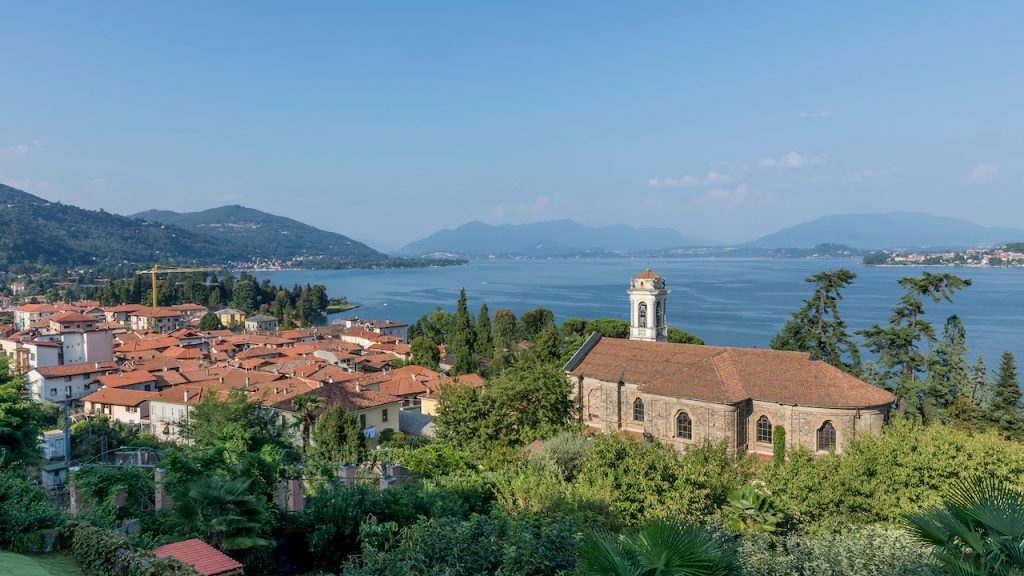
Meina is affectionately known as the ‘village of villas’ because of the number of superb 19th century villas that it is home to. Not least among these are Villa Eden, Palazzo Bedone, Villa Bonomi and, our favourite, Villa Faraggiana. The latter was built in 1855 as a Summer residence for the Faraggiana family from Novara. At its entrance stand two marble lions whilst its façade was built in a Neoclassical style and has five medallions with the portraits of Dante, Boccaccio, Petrarch, Ariosto and Tasso as well as eleven busts of other key Italian figures from history. It also boasts some beautiful frescoed ceilings. Its gardens form the foundations of the Museo Botanico. It has seen a number of uses since the death of Raffaello Faraggiana including being a care home for the elderly, a refuge for evacuees in the Second World War and a billet for the Jewish survivors of the Nazi concentration camps. Nowadays, visitors can explore the grounds by visiting the Meina Museum which is situated here. This is an educational and interactive museum with exhibits and information on the flora, fauna and wildlife to be found in this area
Meina can also boast a lovely lido with beach and lake access as well as an open air pool.
This 5 bedroom villa in Meina is within walking distance of the town centre and lakeside beaches.
Novaglio
Novaglio is a small village, home to the Romanesque church of Sant’ Agata and to a natural drinking water spring.
Oggebbio
Like some of the other villages and towns on Lake Maggiore, Oggebbio enjoys a unique micro-climate which means that camellias can flourish here. Many flower in Autumn which is unusual across Europe when the flowering is more typically in Spring. And the Kamakura Shibori variety of camellia can also flourish here, able to withstand the Winter snowfalls.
Pallanza
Pallanza is a town that oozes elegance and boasts a very attractive lakefront. To one side sit the Borromean Islands whilst to the other are the colourful facades of the old terraced buildings, carefully maintained and now home to several bustling bars, cafes and restaurants.
The town plays host to a number of important events throughout the year, the most famous of which are the Corso Fiorito (Flower parade) and the Palio Remiero (rowing race), both accompanied by impressive firework displays. The former is held every September. From its humble beginnings in 1909 as a way to showcase the skills of local gardeners and to advertise the beauty of the area, it’s now a spectacular event involving numerous floats decorated with hundreds of thousands of flowers. It’s a truly unique event, not to be missed. The Palio Remiero is a nighttime event, held each August where teams of 8 sailors and a helmsmen compete with bright buoys marking the course to follow on the lake. Just like the flower festival, it attracts hundreds of spectators.
Pallanza is also home to a number of important and interesting buildings so there is plenty to see whatever time of year you visit. Well worth a visit is Villa Giulia, a 19th century mansion built by Bernadino Branca but which is now owned by the local town council. The park that the villa sits in is open year round but the villa itself can also be visited on selected days and frequently hosts art exhibitions. It’s also a popular wedding venue. Other elegant buildings in Pallanza are home to museums including the Palazzo Viani-Dugnani, home to the Museo del Paesaggio and the Palazzo Biumi-Innocenti, which has an interesting collection of sculptures and artworks.
Pino
A small village close to the border with Switzerland, Pino has a lovely beach – the Zenna beach. Whilst it was recently merged with Maccagno and Veddasca to form a new municipality – Maccagno con Pino e Veddasca – until that point, it could claim to jointly hold the record for the longest name of any comune in Italy!
Ideal for a couple or small family, this apartment in Pino is within walking distance of the lakeside beaches.
Porto Valtravaglia

A very pretty little village on the Eastern shores of Lake Maggiore, Porto Valtravaglia holds a weekly market every Monday.
Premeno
Once home to ancient settlers dating back to the Bronze Age and Roman Empire, more recently it was a sought after spot for the upper middle class to build their villas including Villa Calvi, Villa Bonomi, Villa Mangiagelli and Villa Bernocchi. It is also an idyllic setting in the heart of the countryside and a good starting point to explore the traditional rural life of this area. Head a couple of kilometres outside Premeno to Esio and you can see some of the ancient forms of handicraft still in action today including copper, wrought iron and wood working.
Ranco
Ranco is a quiet town on the Eastern side of Lake Maggiore. For anyone with an interest in trains and cars, then make a beeline for the Ogliari Transport Museum which is situated here. Founded in the 1950s, this delightful museum has a rustic charm to it and covers over 200 years of transport history.
Ranco is also well known for the fine dining experience to be enjoyed as its most famous restaurant – Il Sole di Ranco – which has been awarded a Michelin star.
Stay in this 3 bedroom villa in Ranco and you are just a short walk away from the restaurant.
San Giovanni
This is the smallest of the islands on Lake Maggiore and sits just a few metres from the shoreline at Pallanza. Whilst it is not open to visitors, it is possible to enjoy a good view of the island from the mainland. It once belonged to the conductor Arturo Toscanini who lived here between 1927 and 1952. The island dates back centuries though. The first surviving records of its existence date back to 999 AD when a castle and church dedicated to St Michael the Archangel stood on the island. At that time it was known as Isola di Santo Angelo, with the name only changing when the church was demolished. In the 17th century the island was acquired by the Borromeo family who restored the palazzo and improved the gardens.
Santa Caterina del Sasso
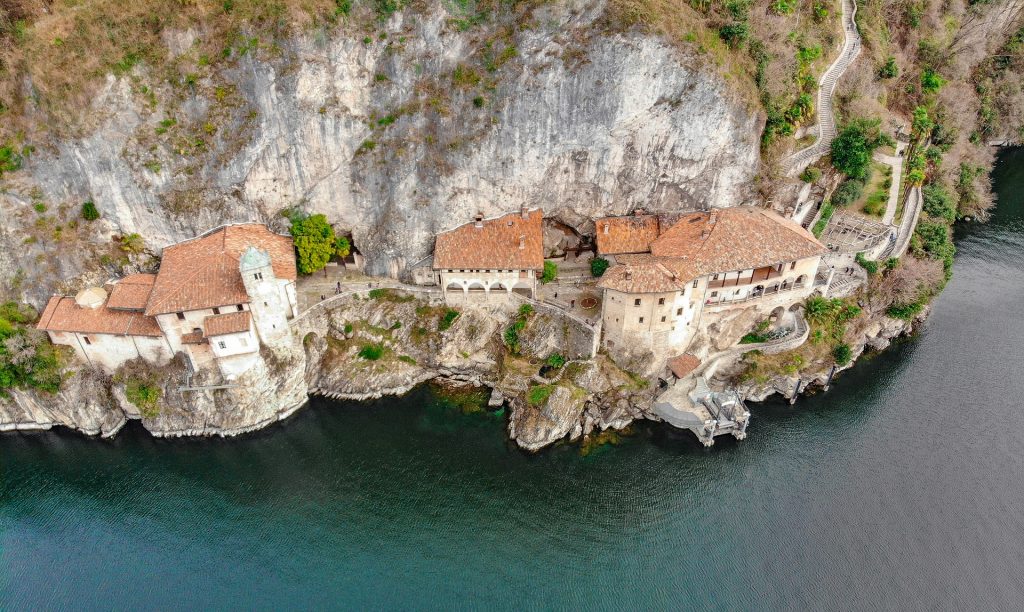
Santa Caterina del Sasso can be reached either by road or also by boat during the summer months. If approaching by road, you will need to climb down 240 steps to reach the hermitage whilst if coming by boat, you will instead climb up 80 steps to reach it.
According to tradition the hermitage was founded by Alberto Besozzi, a rich local merchant who after having survived a heavy storm while crossing the lake decided to retreat to the rocky ledge to live the life of a hermit. These days the monastery is entrusted to the care of the Benedictine monks and contains some important well-kept frescoes dating from the XIVth to the XVlllth century. The hermitage buildings itself date to the late 13th and early 14th centuries.
Nowadays it is one of the most beautiful and intriguing sights on Lake Maggiore run by a community of Oblate Benedictine monks. It comprises three main buildings – the Southern convent, and a smaller convent and a church which opens out on to an inner courtyard.
Stresa
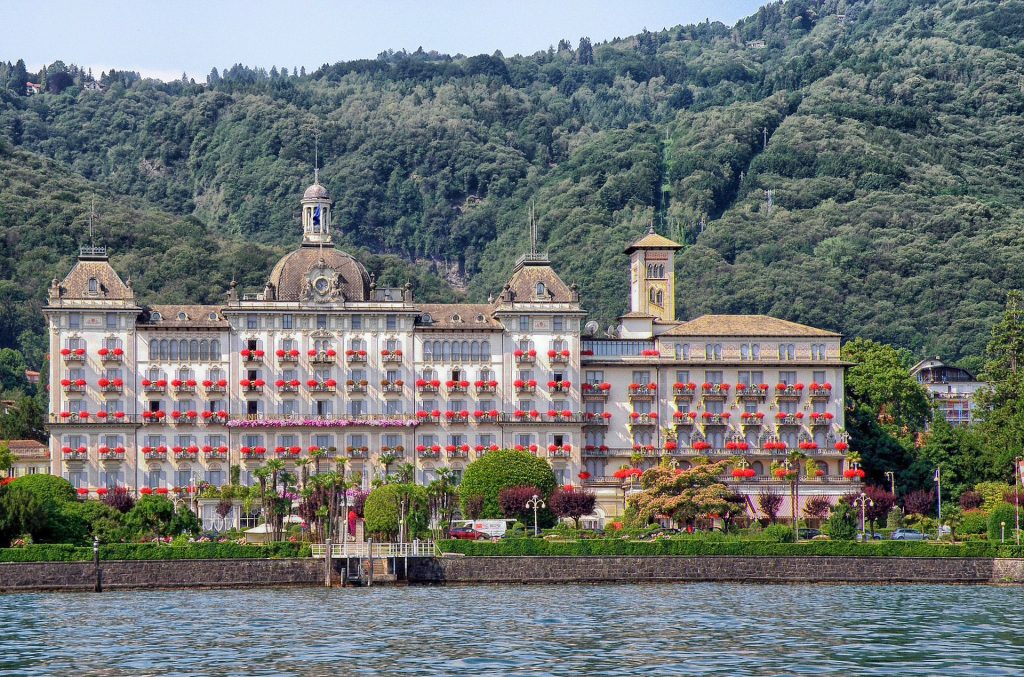
The most famous of the lakeside towns and villages on Lake Maggiore, Stresa has been popular among tourists for centuries. Ever since it was part of the Grand Tour in the 19th century following the opening of the Simplon Tunnel that allowed much more widespread international travel, foreign visitors have flocked to its shores. It was at this time that glamorous villas such as the Villa Pallavicino and Villa Vignolo were built.
However, Stresa’s main attraction actually lies just off shore – the Borromean Islands. Made up of 3 different islands – Isola Bella, Isola Madre and Isola Pescatori – their stunning palaces and gardens (and famous white peacocks) are not to be missed. As the name suggests, it was the Borromeo family that commissioned the palaces to be built. They ruled the region following the demise of the lords of Castello and Visconti and remained in power until Stresa passed into Austrian hands in 1719, before coming under the rule of the House of Savoy in 1748.
Nature lovers still have plenty in store to enjoy elsewhere in Stresa though including at the Botanical Garden Alpinia.
And do take the time to head above Stresa via the Stresa-Alpino-Mottarone cable car (www.stresa.mottarone.it) particularly if you are visiting Stresa on a clear day. It takes 20 minutes to reach an altitude of nearly 1.5 kilometres above sea level but the journey is well worth it. At the summit, you will be rewarded with the most incredible 360 degree views from the Po Valley to the summit of the Alps. On the very clearest of days you will even see all seven lakes from the summit (Lake Maggiore, Lake Orta, Lake Mergozzo, Lake Varese, Lake Comabbio, Lake Monate and Lake Biandronno).
Stresa itself is lined with many elegant lakeside hotels and luxury villas and this genteel vibe is echoed in many of the cultural events it holds each year. Probably the most famous of these is the Settimane Musicali di Stresa. Held each August and September, it is a 4 week event featuring a host of classical music concerts and recitals.
Explore all that Stresa has to offer using this 3 bedroom apartment in Stresa as the base for your next holiday.
Suna
This charming lakeside village enjoys lovely views of Isola Madre and Isolino San Giovanni. It is also known for its collection of engravings not found anywhere else. The so-called ‘Nine men’s morris’ engraving represents a board for the ancient game also known as ‘Mill’ or “Merels’ or ‘Ninepenny marl’ in English. The 12th century Oratory of Santi Sebastiano e Fabiano is certainly most famous for its engravings of the Gioco del Mulino, which appears not only on the steps into the church but also at its entrance and on a pillar in its interior. The game itself is a strategy game for two players which dates back to Roman times. There are plenty more examples of the engraving in Suna itself, most of which measure approximately 30 cm by 30 cm.
Of more interest to many is Suna’s lido. Situated just a few metres from the ancient village, the lido has two large swimming pools, restaurant and bars as well as free beach access.
This luxury Italian Lakes villa in Suna will allow you to explore the town for yourself.
Valle Maggia
Vallemaggia is a stunning Alpine Valley that can boast over 700 km of hiking trails. Right at the base of the valley are some great sandy beaches alongside the river with shallow waters perfect for paddling. It’s worth taking a bucket and spade with you – it’s some of the best sand we’ve discovered around Lake Maggiore.
Val Verzasca

Valle Verzasca s definitely worth a visit, particularly on a hot sunny day. You can visit the Verzasca Dam which features in the opening sequence of Goldeneye. Measuring 220 metres high and 380 metres long, it is the fourth highest dam in Switzerland. Visitors can also walk across it.
Driving on up the mountain from the dam, there are parking spots which give you access to the river. The river is fantastic to swim in and the setting is absolutely idyllic but please do be extremely careful. The currents are extremely strong and the water can be icily cold at certain times of year. You certainly need to be on your guard, especially with young children. You’ll notice the warning signs all around the car parking areas. But, don’t let this put you off – it is a wonderful place.
Verbania
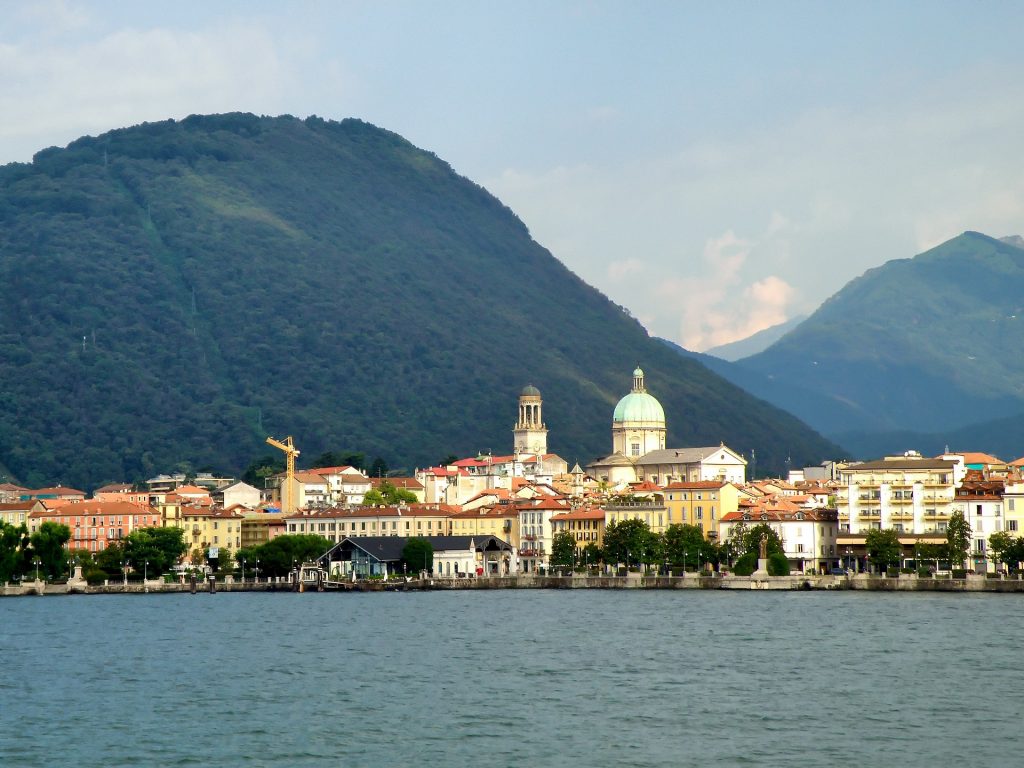
Verbania is home to a number of impressive 19th century mansions including Villa Taranto which is definitely worth a visit. While the villa is not open to the public, the beautiful gardens are open from April until October and were the creation of Captain Neil McEacharn. Back in 1931 the Scottish Captain decided to buy the estate called “La Crocetta” from the Marquise of Sant’Elia to transform it into a specimen of an English Garden, situated in a strip of Italy which could remind him of his native Scotland. Each year, from the 25 of April to the 1st of May, there is an initiative called “The Feast of the Tulip”, when all visitors have the potential to receive a free plant cultivated in the garden. One in five adult tickets has a stamp on the back, which allows people to collect their gift.
Not far from Verbania is the Fondotoce Nature Reserve which boasts a number of well laid out paths including a self-guided nature trail.
Vignone
Set up in the hills above Lake Maggiore, the views from Vignone are stunning but it’s also a great starting point to enjoy some wonderful hikes and mountain bike rides. The area has a long and fascinating history dating back to prehistoric times and visitors can see a number of ancient engravings along their walks that researchers believe date back to the Middle Bronze Age (1600-1250 BC).


